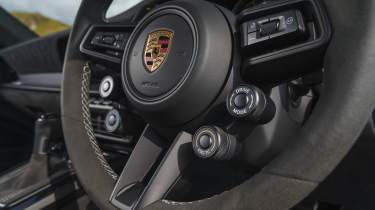Porsche 911 GT3 RS – engine, gearbox and technical highlights
Everything from the 4-litre flat-six to its adjustable suspension and Cup car-style aero scream motorsport
Despite the radical trackday makeover there’s reassuring familiarity in the RS’s 4-litre naturally aspirated flat-six and seven-speed PDK transmission. The motor really has been squeezed until its pips squeak to find an extra 15bhp in the face of stringent emission regs. This gain lifts the total to 518bhp at 8500rpm thanks to the adoption of RS-specific cylinder heads, camshafts and throttle bodies (now one per cylinder). Airflow management has also been optimised to ensure hot air is channelled along the flanks of the car, while colder, denser air runs over the roof and into the intake scoop in the top of the engine cover.
There’s so much detail to unpack, but so much of it seems like it would be irrelevant for the road. The RS is a downforce monster and a great deal of the engineering in the car is to create phenomenal load and utilise it as best as possible. It defines the entire car – from the single, centrally mounted radiator that lives where once your overnight bag would go, to the massive swan-neck rear wing with adjustable rake and an operating range of 34 degrees, from low drag to full airbrake deployment. Who thought there would ever be a DRS button on the steering wheel of a 911? The peak downforce figure – 860kg at 177mph – beats that of a 992 GT3 Cup car and is in the lower range of a full-on 911 RSR set up for the long straights at Le Mans.
More reviews
Group tests
In-depth reviews
Long term tests
Reviews
You’re unlikely to reach 177mph unless you’re on a runway, so instead let’s examine some of the other intriguing aspects of this 518bhp, 1450kg road car. It is a road car, after all. Most fascinating of all during our time on weather-beaten surfaces with unpredictable humps, material changes and strange cambers was the adjustable nature of the suspension. It has all the really cool stuff you’d expect, of course. This Weissach Package car has carbonfibre anti-roll bars (saving 1.5kg at each end), plus the delightfully geeky aero-optimised front control arms and gorgeous magnesium wheels (saving another 8kg). But you can also adjust bump and rebound for front and rear dampers on the fly via simple rotary controls on the steering wheel. Could this be a magic bullet to tame the RS for road use?
Funnily enough, this configurability is only unlocked in Track mode, which is reached by toggling through Normal and Sport modes. To confuse matters further, it’s still possible to stiffen or relax the dampers to a pre-determined level in these modes with the damper button on the centre console, as per the standard GT3.
It all sounds head-meltingly complex but, in reality, you find yourself simply driving in Normal mode, or going straight to Track so you can play with the dampers manually. Bump and rebound settings range from -4 to +4 with the default set to zero. Porsche has been careful to ensure that even if somebody selected, for example, full soft on the front and full hard on the rear, the balance won’t be dangerously wayward. When you consider that the RS is fully rose-jointed and has spring rates 50 per cent stiffer than the already uncompromising 992 GT3, you’d imagine that away from the confines of a racetrack it might all be in vain…



